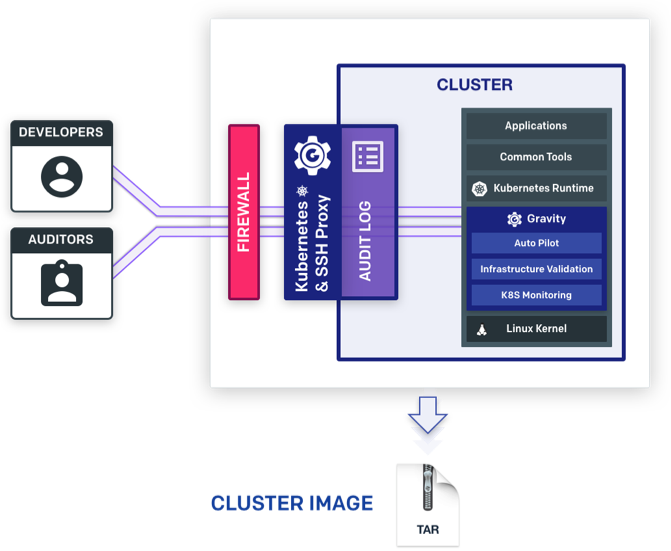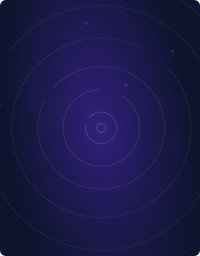Home - Teleport Blog - Gravity 5.5 gives superpowers to Helm: package Kubernetes apps as self-contained tarballs - Mar 18, 2019
Gravity 5.5 gives superpowers to Helm: package Kubernetes apps as self-contained tarballs
What's new in this release?
With the release of Gravity v5.5, the open source image-based Kubernetes packaging solution, we added support for Helm charts. This allows developers to use Helm to package entire Kubernetes clusters, pre-loaded with applications into downloadable image files. Earlier versions of Gravity relied on a proprietary application manifest format. With Helm support, developers can leverage their existing tooling and skills.
For those that like to learn by doing, we have prepared a Quickstart Guide that runs through how to build a cluster image and install it across multiple nodes. Below is a further explanation of Gravity and the how the new features in v5.5 work.
What is Gravity?
Gravity enables true application portability for complex, cloud-native applications that require multi-node clusters. It is an open source solution for application developers. This release makes it possible for organizations to deliver application catalogs across public and private clouds to do things like:
- Package multiple cloud-native applications into a Kubernetes cluster and build a dependency-free cluster image from it.
- Publish cluster images into an application catalog or simply upload them to S3-like cloud storage.
- The users of cluster images can create full replicas of the original cluster with a few clicks or simple command line installer.
- Image publishers can remotely manage all cluster replicas, greatly simplifying application and Kubernetes updates across many clusters located in different cloud providers, behind firewalls and even air-gapped environments.
How does building a cluster image work?
Gravity includes a command line package builder, which allows developers to point at their Helm charts and produce a standalone, downloadable cluster image file. Such image files have no dependencies and can be used to distribute complex, cloud-native applications to end users.
Developers use tele, the Gravity command line tool for building cluster images:


Developers can simply execute:
$ tele build [helm-chart.yaml]
And the cluster image will be built and saved as .tar file. The resulting image can be quite large because it includes:
- All container images
- All of the Kubernetes binaries (and their dependencies)
- Gravity's installer to easily provision new clusters using the image.
- Gravity's Kubernetes "hypervisor" used to provide automatic cluster management to reduce operational overhead.
How does creating a cluster work?
The end users can download a cluster image from either Gravity Enterprise or from another medium, such as cloud storage or even a USB stick for air-gapped servers. The cluster image uses a simple archive file format, i.e. it can be extracted and installed by executing a simple installer command.
# We are executing this on the node named 'host' with IP address of 10.5.5.28
# and creating a token for other nodes to join securely.
$ sudo ./gravity install \ \
--advertise-addr=10.5.5.28 \ \
--token=secret
The built-in installer is capable of provisioning Kubernetes clusters pre-loaded with the applications from a cluster image. Kubernetes clusters provisioned by Gravity are managed by a Gravity cluster hypervisor which takes care of etcd and K8s monitoring and management. Gravity clusters are highly-available, do not require proactive management and include a built-in authentication gateway for both Kubernetes and SSH.


As the diagram shows, the cluster image file is all you need to create a Kubernetes cluster from scratch. Even access to the Internet is not necessary.
How do Kubernetes Appliances work?
Below is a diagram of a Kubernetes virtual appliance created from a Gravity image file:


Each cluster consists of:
- Multi-master Kubernetes configuration managed by Gravity's "Kubernetes hypervisor".
- The
gravityhypervisor process (shown in gray above) running on every node as a container which contains and manages all K8s services inside. - Embedded Docker registry, managed by Gravity hypervisor.
- K8s/SSH authentication gateway with easy integration with SAML/OIDC providers for single sign-on (SSO). The gateway supports an outbound tunnel to allow remote management if the appliance is running behind NAT.
- Detailed audit log for all SSH connections and K8s API calls. Gravity even records all keystrokes and output for interactive sessions, again for both SSH and Kubernetes.
Low-level commands like kubeadm or etcdctl/etcdadm are no longer necessary to manage a cluster. Gravity high-level commands allow users to expand/shrink clusters, perform in-place Kubernetes upgrades or application upgrades using automatic or image-based methods.
Cluster Image Catalog
Gravity Enterprise includes an application catalog - a place where developers can publish cluster images. Typical use cases for the application catalog include:
- A centralized place to publish pre-configured Kubernetes clusters that are approved by compliance and security teams for production within an organization.
- A mechanism to distribute cloud-native SaaS applications as downloadable software. A typical scenario would be a SaaS company that offers its solution to be downloaded and installed on the premises of its enterprise customers.
Multi-cluster authentication gateway
Gravity Enterprise also includes Teleport, privileged access management (PAM) solution which allows developers to:
- Easily authenticate against a single authentication gateway using the command line (CLI) environment or a web GUI.
- Retrieve automatically expiring credentials for both SSH and Kubernetes API endpoints for all clusters within their organization.
- Access clusters located behind firewalls or NAT without the need for a VPN.
The centralized application catalog and the central authentication gateway allow organizations to manage access and compliance of their Kubernetes deployments across multiple cloud providers and even 3rd party infrastructure, while simultaneously reducing operational overhead of running cloud-native applications globally.
Teleport cybersecurity blog posts and tech news
Every other week we'll send a newsletter with the latest cybersecurity news and Teleport updates.
How to start using Gravity?
Gravity is open sourced and available under an Apache 2.0 license on Github. We have prepared a Quickstart Guide that runs through most of what we have described above. You can also review the full documentation online and reach out to us through the Gravity community forum with any questions.
We believe that running applications anywhere should be easier. That's why we also built Teleport - Teleport allows engineers and security professionals to unify access for SSH servers, Kubernetes clusters, web applications, and databases across all environments. Learn more here!
Tags
Teleport Newsletter
Stay up-to-date with the newest Teleport releases by subscribing to our monthly updates.

Subscribe to our newsletter

